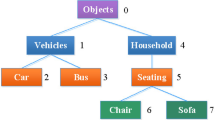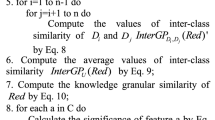Abstract
In the era of big data, there exist complex structure between different classes labels. Hierarchical structure, among others, has become a representative one, which is mathematically depicted as a tree-like structure or directed acyclic graph. Most studies in the literature focus on static feature selection in hierarchical information system. In this study, in order to solve the incremental feature selection problem of hierarchical classification in a dynamic environment, we develop two incremental algorithms for this purpose (IHFSGR-1 and IHFSGR-2 for short). As a preliminary step, we propose a new uncertainty measure to quantify the amount of information contained in the hierarchical classification system, and based on this, we develop a non-incremental hierarchical feature selection algorithm. Next, we investigate the updating mechanism of this uncertainty measure upon the arrival of samples, and propose two strategies for adding and deleting features, leading to the development of two incremental algorithms. Finally, we conduct some comparative experiments with several non-incremental algorithms. The experimental results suggest that compared with several non-incremental algorithms, our incremental algorithms can achieve better performance in terms of the classification accuracy and two hierarchical evaluation metrics, and can significantly accelerate the fuzzy rough set-based hierarchical feature selection.










Similar content being viewed by others
Explore related subjects
Discover the latest articles, news and stories from top researchers in related subjects.Data Availability
The datasets generated during and analyzed during the current study are available from the corresponding author on reasonable request.
References
Gemmeke, J.F., Ellis, D.P., Freedman, D., Jansen, A., Lawrence, W., Moore, R.C., Plakal, M., Ritter, M.: Audio set: an ontology and human-labeled dataset for audio events. In: 2017 IEEE International Conference on Acoustics, Speech and Signal Processing (ICASSP), pp. 776–780 (2017). https://doi.org/10.1109/ICASSP.2017.7952261
Deng, J., Dong, W., Socher, R., Li, L.J., Li, K., Fei Fei, L.: Imagenet: a large-scale hierarchical image database. In: 2009 IEEE Conference on Computer Vision and Pattern Recognition, pp. 248–255 (2009). https://doi.org/10.1109/cvpr.2009.5206848
Kabir, A., Shehu, A.: Goproformer: a multi-modal transformer method for gene ontology protein function prediction. Biomolecules 12(11), 1709 (2022). https://doi.org/10.3390/biom12111709
Seshadri, K., Maruthappan, A., Sundar Raman, M.: A scalable parallel algorithm for building web directories. Concurr. Comp.-Pract. E 33(9), 6121 (2021). https://doi.org/10.1002/cpe.6121
Omosebi, P.A., Adewole, A.P., Sennaike, O.: Web page prediction model using machine learning approaches: a review. In: 2023 International Conference on Science, Engineering and Business for Sustainable Development Goals (SEB-SDG), vol. 1, pp. 1–10 (2023). https://doi.org/10.1109/SEB-SDG57117.2023.10124586
Galshetwar, G., Waghmare, L.M., Gonde, A.B., Murala, S.: Local energy oriented pattern for image indexing and retrieval. J. Vis. Commun. Image Represent 64, 102615 (2019). https://doi.org/10.1016/j.jvcir.2019.102615
Deng, J., Berg, A.C., Fei-Fei, L.: Hierarchical semantic indexing for large scale image retrieval. In: CVPR 2011, pp. 785–792 (2011). https://doi.org/10.1109/CVPR.2011.5995516
Zadeh, L.A.: Fuzzy sets. Inf. Control 8(3), 338–353 (1965). https://doi.org/10.1016/S0019-9958(65)90241-X
Shen, Y., E, H., Chen, T., Xiao, Z., Liu, B., Chen, Y.: High-dimensional data clustering with fuzzy c-means: problem, reason, and solution. In: International Work-Conference on Artificial Neural Networks, pp. 89–100 (2021). https://doi.org/10.1007/978-3-030-85030-2_8
Ruspini, E.H., Bezdek, J.C., Keller, J.M.: Fuzzy clustering: a historical perspective. IEEE Comput. Intell. M 14(1), 45–55 (2019). https://doi.org/10.1109/MCI.2018.2881643
Hu, L., Pan, X., Tang, Z., Luo, X.: A fast fuzzy clustering algorithm for complex networks via a generalized momentum method. IEEE Trans. Fuzzy Syst. 30(9), 3473–3485 (2021). https://doi.org/10.1109/TFUZZ.2021.3117442
Hanyu, E., Cui, Y., Pedrycz, W., Fayek, A.R., Li, Z., Li, J.: Design of fuzzy rule-based models with fuzzy relational factorization. Expert Syst. Appl. 206, 117904 (2022). https://doi.org/10.1016/j.eswa.2022.117904
Hu, X., Pedrycz, W., Wang, X.: Granular fuzzy rule-based models: a study in a comprehensive evaluation and construction of fuzzy models. IEEE Trans. Fuzzy Syst. 25(5), 1342–1355 (2016). https://doi.org/10.1109/TFUZZ.2016.2612300
Dubois, D., Prade, H.: Rough fuzzy sets and fuzzy rough sets. Int. J. Gen. Syst. 17(2–3), 191–209 (1990). https://doi.org/10.1080/03081079008935107
Pawlak, Z.: Rough sets. Int. J. Comput. Inf. sci. 11, 341–356 (1982). https://doi.org/10.1007/BF01001956
Wang, C., Qi, Y., Shao, M., Hu, Q., Chen, D., Qian, Y., Lin, Y.: A fitting model for feature selection with fuzzy rough sets. IEEE Trans. Fuzzy Syst. 25(4), 741–753 (2016). https://doi.org/10.1109/TFUZZ.2016.2574918
Wang, C., Huang, Y., Shao, M., Fan, X.: Fuzzy rough set-based attribute reduction using distance measures. Knowl. Based Syst. 164, 205–212 (2019). https://doi.org/10.1016/j.knosys.2018.10.038
Wang, C., Huang, Y., Ding, W., Cao, Z.: Attribute reduction with fuzzy rough self-information measures. Inf. Sci. 549, 68–86 (2021). https://doi.org/10.1016/j.ins.2020.11.021
Ni, P., Zhao, S., Wang, X., Chen, H., Li, C.: Para: a positive-region based attribute reduction accelerator. Inf. Sci. 503, 533–550 (2019). https://doi.org/10.1016/j.ins.2019.07.038
Dai, J., Hu, H., Wu, W.-Z., Qian, Y., Huang, D.: Maximal-discernibility-pair-based approach to attribute reduction in fuzzy rough sets. IEEE Trans. Fuzzy Syst. 26(4), 2174–2187 (2017). https://doi.org/10.1109/TFUZZ.2017.2768044
Hu, Q., Yu, D., Xie, Z., Liu, J.: Fuzzy probabilistic approximation spaces and their information measures. IEEE Trans. Fuzzy Syst. 14(2), 191–201 (2006). https://doi.org/10.1109/TFUZZ.2005.864086
Hu, Q., Yu, D., Xie, Z.: Information-preserving hybrid data reduction based on fuzzy-rough techniques. Pattern Recognit. Lett. 27(5), 414–423 (2006). https://doi.org/10.1016/j.patrec.2005.09.004
Ni, P., Zhao, S., Wang, X., Chen, H., Li, C., Tsang, E.C.: Incremental feature selection based on fuzzy rough sets. Inf. Sci. 536, 185–204 (2020). https://doi.org/10.1016/j.ins.2020.04.038
Yang, Y., Chen, D., Wang, H., Wang, X.: Incremental perspective for feature selection based on fuzzy rough sets. IEEE Trans. Fuzzy Syst. 26(3), 1257–1273 (2017). https://doi.org/10.1109/TFUZZ.2017.2718492
Zhang, X., Mei, C., Chen, D., Yang, Y., Li, J.: Active incremental feature selection using a fuzzy-rough-set-based information entropy. IEEE Trans. Fuzzy Syst. 28(5), 901–915 (2019). https://doi.org/10.1109/TFUZZ.2019.2959995
Huang, H., Liu, H.: Feature selection for hierarchical classification via joint semantic and structural information of labels. Knowl. Based Syst. 195, 105655 (2020). https://doi.org/10.1016/j.knosys.2020.105655
Wang, Q., Wan, J., Nie, F., Liu, B., Yan, C., Li, X.: Hierarchical feature selection for random projection. IEEE Trans. Neural Netw. Learn. Syst. 30(5), 1581–1586 (2018). https://doi.org/10.1109/TNNLS.2018.2868836
Lima, H.C., Otero, F.E., Merschmann, L.H., Souza, M.J.: A novel hybrid feature selection algorithm for hierarchical classification. IEEE Access 9, 127278–127292 (2021). https://doi.org/10.1109/ACCESS.2021.3112396
Zhao, H., Wang, P., Hu, Q., Zhu, P.: Fuzzy rough set based feature selection for large-scale hierarchical classification. IEEE Trans. Fuzzy Syst. 27(10), 1891–1903 (2019). https://doi.org/10.1109/TFUZZ.2019.2892349
Qiu, Z., Zhao, H.: A fuzzy rough set approach to hierarchical feature selection based on Hausdorff distance. Appl. Intell. 52(10), 1–14 (2022). https://doi.org/10.1007/s10489-021-03028-4
Huang, W., She, Y., He, X., Ding, W.: Fuzzy rough sets-based incremental feature selection for hierarchical classification. IEEE Trans. Fuzzy Syst. 31(10), 3721–3733 (2023). https://doi.org/10.1109/TFUZZ.2023.3300913
Bai, S., Lin, Y., Lv, Y., Chen, J., Wang, C.: Kernelized fuzzy rough sets based online streaming feature selection for large-scale hierarchical classification. Appl. Intell. 51(3), 1602–1615 (2021). https://doi.org/10.1007/s10489-020-01863-5
She, Y., Wu, J., He, X.: An incremental approach to hierarchical feature selection by applying fuzzy rough set technique. Artif. Intell. Rev. 56, 2571–2598 (2023). https://doi.org/10.1007/s10462-023-10584-3
Zhao, S., Tsang, E.C.: On fuzzy approximation operators in attribute reduction with fuzzy rough sets. Inf. Sci. 178(16), 3163–3176 (2008). https://doi.org/10.1016/j.ins.2008.03.022
Silla, C.N., Freitas, A.A.: A survey of hierarchical classification across different application domains. Data Min. Knowl. Disc. 22(1), 31–72 (2011). https://doi.org/10.1007/s10618-010-0175-9
Kosmopoulos, A., Partalas, I., Gaussier, E., Paliouras, G., Androutsopoulos, I.: Evaluation measures for hierarchical classification: a unified view and novel approaches. Data Min. Knowl. Disc. 29(3), 820–865 (2015). https://doi.org/10.1007/s10618-014-0382-x
Zhao, H., Hu, Q., Zhu, P., Wang, Y., Wang, P.: A recursive regularization based feature selection framework for hierarchical classification. IEEE Trans. Knowl. Data Eng. 33(7), 2833–2846 (2019). https://doi.org/10.1109/TKDE.2019.2960251
Zhang, X., Mei, C., Chen, D., Li, J.: Feature selection in mixed data: a method using a novel fuzzy rough set-based information entropy. Pattern Recognit. 56, 1–15 (2016). https://doi.org/10.1016/j.patcog.2016.02.013
Jia, P., Dai, J., Pan, Y.: Novel algorithm for attribute reduction based on mutual-information gain ratio. J. Zhejiang Univ. Eng. Sci. 40(6), 1041 (2006)
Dai, J., Xu, Q.: Attribute selection based on information gain ratio in fuzzy rough set theory with application to tumor classification. Appl. Soft Comput. 13(1), 211–221 (2013). https://doi.org/10.1016/j.asoc.2012.07.029
Li, D., Ju, Y., Zou, Q.: Protein folds prediction with hierarchical structured SVM. Curr. Proteom 13(2), 79–85 (2016). https://doi.org/10.2174/157016461302160514000940
Wan, J., Chen, H., Li, T., Yuan, Z., Liu, J., Huang, W.: Interactive and complementary feature selection via fuzzy multigranularity uncertainty measures. IEEE Trans. Cybern. 53(2), 1208–1221 (2023). https://doi.org/10.1109/TCYB.2021.3112203
She, Y., Wu, J., He, X.: Hierarchical classification feature selection algorithm based on sample pair selection. J. KunMing Univ. Sci. Technol. 47(240), 92–102 (2022). https://doi.org/10.16112/j.cnki.53-1223/n.2022.05.136
Peng, H., Long, F., Ding, C.: Feature selection based on mutual information criteria of max-dependency, max-relevance, and min-redundancy. IEEE Trans. Pattern Anal. Mach. Intell. 27(8), 1226–1238 (2005). https://doi.org/10.1109/TPAMI.2005.159
Chen, T., Guestrin, C.: Xgboost: A scalable tree boosting system. In: Proceedings of the 22nd Acm Sigkdd International Conference on Knowledge Discovery and Data Mining, pp. 785–794 (2016). https://doi.org/10.1145/2939672.2939785
Dekel, O., Keshet, J., Singer, Y.: Large margin hierarchical classification. In: Proceedings of the Twenty-first International Conference on Machine Learning, p. 27. Association for Computing Machinery, New York (2004). https://doi.org/10.1145/1015330.1015374
Struyf, J., Džeroski, S., Blockeel, H., Clare, A.: Hierarchical multi-classification with predictive clustering trees in functional genomics. In: Bento, C., Cardoso, A., Dias, G. (eds.) Portuguese Conference on Artificial Intelligence, pp. 272–283. Springer, Heidelberg (2005). https://doi.org/10.1007/11595014_27
Friedman, M.: A comparison of alternative tests of significance for the problem of m rankings. Ann. Math. Stat. 11(1), 86–92 (1940). https://doi.org/10.1214/aoms/1177731944
Dunn, O.J.: Multiple comparisons among means. J. Am. Stat. Assoc. 56(293), 52–64 (1961). https://doi.org/10.2307/2282330
Acknowledgements
This work was supported by the National Nature Science Foundation of China under Grants 61976244 and 12001422, the Nature Science Foundation of Shaanxi Province under Grants 2021JQ-580 and 2023-JC-YB-597, and the Postgraduate Innovation and Practice Ability Development Fund of Xi’an Shiyou University under Grant YCS22112071.
Author information
Authors and Affiliations
Contributions
Yang Tian: Conceptualization, Methodology, Software, Validation, Investigation, Formal analysis, Visualization, Writing-original draft; Yanhong She: Conceptualization, Methodology, Writing-original draft, Supervision.
Corresponding author
Ethics declarations
Conflict of interest
The authors have no Conflict of interest to declare that are relevant to the content of this article.
Ethical Approval
Not applicable.
Informed Consent
Not applicable.
Rights and permissions
Springer Nature or its licensor (e.g. a society or other partner) holds exclusive rights to this article under a publishing agreement with the author(s) or other rightsholder(s); author self-archiving of the accepted manuscript version of this article is solely governed by the terms of such publishing agreement and applicable law.
About this article
Cite this article
Tian, Y., She, Y. Uncertainty Measure-Based Incremental Feature Selection For Hierarchical Classification. Int. J. Fuzzy Syst. 26, 2074–2096 (2024). https://doi.org/10.1007/s40815-024-01708-0
Received:
Revised:
Accepted:
Published:
Issue Date:
DOI: https://doi.org/10.1007/s40815-024-01708-0




